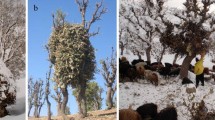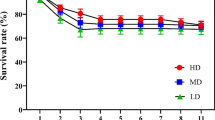Abstract
The growth rate of forest trees indicates the rate of wood production and overall tree health. Tree growth also indicates resource distribution and the effect of ecological variables. Silvicultural treatments may improve the growth and resilience of trees growing in dehesas (Mediterranean open-woodland forests). These ecosystems are expected to experience increased temperature and decreased precipitation due to global climate change; hence their management is a key factor contributing to the adaption, and hence the conservation of these systems. In this paper, we analyzed the effect of traditional silvicultural treatments on the intra-annual stem growth of holm oak (Quercus ilex L.) in three dehesa plots in SW Spain: (i) soil treatments (ploughing, or ploughing + fertilization with calcium superphosphate + sowing with the legume yellow lupin, Lupinus luteus) and (ii) pruning intensity (heavy, moderate, or light). The soil treatments had no significant effects on growth, but pruning significantly affected growth patterns. Heavy pruning slightly reduced growth during the spring, and moderate and heavy pruning increased the normal stem contractions (due to water stress during drought) and expansions (due to rehydration after drought) in sites with poorly developed soils or other stress causes. Hence, heavy pruning could affect the vigor and vegetative status of trees in areas where tree survival is already compromised. Light pruning did not affect tree growth, so this treatment may be acceptable if the extraction of firewood or biomass is one of the management objectives.


Similar content being viewed by others
References
Aerts R (1995) The advantages of being evergreen. Trends Ecol Evol 10:402–407
Akaike H (1974) A new look at the statistical model identification. IEEE Trans Autom Control 19(6):716–723
Alejano R, Tapias R, Fernández M, Torres E, Alaejos J, Domingo J (2008) Influence of pruning and the climatic conditions on acorn production in Holm oak (Quercus ilex L.) dehesas in SW Spain. Ann For Sci 65(2):209
Alejano R, Vázquez-Piqué J, Carevic F, Fernández M (2011) Do ecological and silvicultural factors influence acorn mass in Holm Oak (southwestern Spain)? Agrofor Syst 83:25–39
Balandier P, Lacointe A, Le Roux X, Sinoquet H, Cruiziat P, Le Dizès S (2000) “SIMWAL”: a structure—function model simulating single walnut tree growth according to climate and pruning. Ann For Sci 57:571–585
Bramley H, Turner NC, Turner DW, Tyerman SD (2009) Roles of morphology, anatomy, and aquaporins in determining contrasting hydraulic behavior of roots. Plant Physiol 150:348–364
Brasier CM (1995) Phytophthora cinnamomi and oak decline in southern Europe. Environmental constraints including climate change. Ann For Sci 53:347–358
Bravo JA, Roig S, Serrada R (2008) Selvicultura en montes bajos y medios de Quercus ilex L., Quercus pyrenaica Willd. y Quercus faginea Lam. In: Serrada R, Montero G, Reque JA (eds) Compendio de Selvicultura aplicada en España. INIA, Madrid, pp 657–744
Campelo F, Gutiérrez E, Ribas M, Nabais C, Freitas H (2007) Relationships between climate and double rings in Quercus ilex from northeast Spain. Can J For Res 37:1915–1923
Campelo F, Nabais C, García-González I, Cherubini P, Gutiérrez E, Freitas H (2009) Dendrochronology of Quercus ilex L. and its potential use for climate reconstruction in the Mediterranean region. Can J For Res 39:2486–2493
Cañellas I, Roig S, Poblaciones MJ, Gea-Izquierdo G, Olea L (2007) An approach to acorn production in Iberian dehesas. Agrofor Syst 70:3–9
Carevic FS, Fernández M, Alejano R, Vázquez-Piqué J, Tapias R, Corral E, Domingo J (2010) Plant water relations and edapho-climatic conditions affecting acorn production in a holm oak (Quercus ilex L. ssp. ballota) open woodland. Agrofor Syst 78:299–308
Cartan-Son M, Floret C, Galan MJ, Grandjanny M, Le Floc’h E, Maistre M, Perret P, Romane F (1992) Factors affecting radial growth of Quercus ilex L. in a coppice stand in southern France. Vegetatio 99–100:61–68
Coelho COA, Ferreira AJD, Laouina A, Hamza A, Chaker M, Naafa R, Regaya K, Boulet AK, Keizer JJ, Carvalho TMM (2004) Changes in land use and land management practices affecting land degradation within forest and grazing ecosystems in the Western Mediterranean. In: Schnabel S, Ferreira A (eds) Advances in GeoEcology 37: Sustainability of Agrosilvopastoral Systems—Dehesas, Montados. Catena Verlag, Reiskirchen, pp 137–153
Cubera E, Moreno G (2007a) Effect of land-use on soil water dynamics in dehesas of Central-Western Spain. Catena 71:298–308
Cubera E, Moreno G (2007b) Effect of single Quercus ilex trees upon spatial and seasonal changes in soil water content in dehesas of Central Western Spain. Ann For Sci 64:355–364
Dagit R, Downer J (2002) To Prune or Not to Prune: Responses of Coast Live Oaks (Quercus agrifolia) to Canopy Retention during Transplanting. USDA Forest Service. http://www.californiaoaks.org/ExtAssets/RosiDagitTransplantingOaks.pdf. Accessed 20 August 2011
Eichhorn MP, Paris P, Herzog F, Incoll LD, Liagre F, Mantzanas K, Mayus M, Moreno G, Papanastasis VP, Pilbeam DJ, Pisanelli A, Dupraz C (2006) Silvoarable systems in Europe—past, present and future prospects. Agrofor Syst 67:29–50
Fritts HC (1976) Tree rings and climate. Academic Press, London
Gallardo A, Covelo F, Morillas L, Delgado M (2009) Ciclos de nutrientes y procesos edáficos en los ecosistemas terrestres: especificidades del caso mediterráneo y sus implicaciones para las relaciones suelo-planta. Ecosistemas 18:4–19
Gea-Izquierdo G, Cherubini P, Cañellas I (2011) Tree-rings reflect the impact of climate change on Quercus ilex L. along a temperature gradient in Spain over the last 100 years. For Ecol Manage 262:1807–1816
Gómez-Aparicio L, Pérez-Ramos IM, Mendoza I, Quero JL, Matías L, Castro J, Zamora R, Marañón T (2008) Oak seedling survival and growth along resource gradients in Mediterranean forests: implications for regeneration under current and future environmental scenarios. Oikos 117:1683–1699
Gutiérrez E, Campelo F, Camarero JJ, Ribas M, Muntán E, Nabais C, Freitas H (2011) Climate controls act at different scales on the seasonal pattern of Quercus ilex L. stem radial increments in NE Spain. Trees 25:637–646
Gyenge JE, Fernández ME, Schlichter TM (2009) Effect of pruning on branch production and water relations in widely spaced ponderosa pines. Agrofor Syst 77:223–235
Gyenge JE, Fernández ME, Schlichter TM (2010) Effect of stand density and pruning on growth of ponderosa pines in NW Patagonia, Argentina. Agrofor Syst 78:233–241
IPCC (2007) Climate change 2007: synthesis report. In: Core Writing Team, Pachauri RK, Reisinger A (eds) Contribution of working groups I, II and III to the fourth assessment report of the intergovernmental panel on climate Change. IPCC, Geneva, pp. 104
IUSS Working Group WRB (2007) World reference base for soil resources 2006, first update 2007, world soil resources reports no. 103. FAO, Rome
Jackson NA, Wallace JS, Ong CK (2000) Tree pruning as a means of controlling water use in an agroforestry system in Kenia. For Ecol Manag 126:133–148
Keeland BD, Young PJ (2014) Installation of traditional dendrometer bands. U.S. Geological Survey. National Wetlands Research Center. http://www.nwrc.usgs.gov/topics/Dendrometer/. Accessed 23 January 2014
Landsberg JJ (1986) Physiological ecology of forest production. Academic Press, New York, p 198
Littell RC, Milliken GA, Stroup WW, Wolfinger RD, Schabenberger O (2006) SAS system for mixed models. SAS Institute, Cary
Markewitz D, Figueiredo RD, de Carvalho CJR, Davidson EA (2012) Soil and tree response to P fertilization in a secondary tropical forest supported by an Oxisol. Biol Fertil Soils 48:665–678
Martín D, Vázquez-Piqué J, Fernández M, Alejano R (2014) Effect of ecological factors on intra-annual stem girth increment of holm oak. Trees 28:1367–1381
Mayor X, Rodà F (1994) Effects of irrigation and fertilization on stem diameter growth in a Mediterranean holm oak forest. For Ecol Manag 68:119–126
McMaster GS, Jow WM, Kummerow J (1982) Response of Adenostoma fasciculatum and Ceanothus greggii chaparral to nutrient additions. J Ecol 70:745–756
Monk CD (1966) An ecological significance of evergreenness. Ecology 47:504–505
Moreno G, Obrador JJ, Cubera E, Dupraz C (2005) Fine root distribution in dehesas of Central-Western Spain. Plant Soil 277:153–162
Moreno G, Obrador JJ, García E, Cubera E, Montero MJ, Pulido FJ, Dupraz C (2007) Driving competitive and facilitative interactions in oak dehesas with management practices. Agrofor Syst 70:25–40
Natalini F, Alejano R, Vázquez-Piqué FJ, Cañellas, I, Gea-Izquierdo G (2013) Growth trends and sensitivity to climate of declining Mediterranean open woodlands exhibiting widespread mortality in Southern Spain. Second American Dendrochronology Conference Ameridendron. Tucson, Arizona
Navarro R (2011) Situación actual de las dehesas. In: Alejano Monge R, Domingo Santos JM, Fernández, M (eds) Manual para la Gestión Sostenible de las dehesas andaluzas, Foro Encinal - Universidad de Huelva. Huelva, España, pp 62-68
Patterson HD, Thompson R (1971) Recovery of inter-block information when block sizes are unequal. Biometrika 58:545–554
Pinkard EA, Beadle CL (1998) Effects of green pruning on growth and stem shape of Eucalyptus nitens Deane and Maiden (Maiden). New Forest 15:107–126
Pulido FJ, Díaz M (2005) Regeneration of a Mediterranean oak: a whole cycle approach. EcoScience 12:92–102
Quézel P, Médail F (2003) Ecologie et Biogéographie des Forêts du Bassin Méditerranéen. Elsevier, Paris
Ramírez JA, Díaz M (2008) The role of temporal shrub encroachment for the maintenance of Spanish holm oak Quercus ilex dehesas. For Ecol Manag 255:1976–1983
Ringgenberg S (2001) Flow in the phloem. Arborist News 10(1):21–26
Rivest D, Rolo V, López-Díaz ML, Moreno G (2011) Belowground competition for nutrients in shrub-encroached Mediterranean dehesas. Nutr Cycl Agroecosyst 90:347–354
Rolo V, Moreno G (2011) Shrub species affect distinctively the functioning of scattered Quercus ilex trees in Mediterranean open woodlands. For Ecol Manag 261:1750–1759
San Miguel A (1994) La dehesa española: origen, tipología, características y gestión. Fundación Conde del Valle de Salazar, Madrid
Sánchez-Andrés R, Sánchez-Carrillo S, Benítez M, Sánchez-López A (2006) Tillage induced differential morphometric responses and growth patterns in afforestation with Quercus ilex. Soil Tillage Res 90:50–62
Scowcroft PG, Friday JB, Idol T, Dudley N, Haraguchi J, Meason D (2007) Growth response of Acacia koa trees to thinning, grass control, and phosphorus fertilization in a secondary forest in Hawai‘i. For Ecol Manage 239:69–80
Searle SR (1971) Linear Models. John Wiley & Sons, New York
Serrano MS, Fernández P, De Vita P, Carbonero MD, Trapero A, Sánchez ME (2010) Lupinus luteus, a new host of Phytophthora cinnamomi in Spanish oak-rangelands ecosystems. Eur J Plant Pathol 128:149–152
Siddiqui T, Farrakh-Nawaz M, Ahmed I (2010) Effect of different pruning intensities on the growth of Acacia nilotica (Kikar). Agrociencia 44(1):93–97
Acknowledgments
This study was sponsored by the Department of Innovation, Science and Business of the Regional Government of Andalusia, Spain (ref: C03-192) and by MEC-INIA, Spain (ref: SUM2006-00026-00-00).
Author information
Authors and Affiliations
Corresponding author
Rights and permissions
About this article
Cite this article
Martín, D., Vázquez-Piqué, J. & Alejano, R. Effect of pruning and soil treatments on stem growth of holm oak in open woodland forests. Agroforest Syst 89, 599–609 (2015). https://doi.org/10.1007/s10457-015-9794-x
Received:
Accepted:
Published:
Issue Date:
DOI: https://doi.org/10.1007/s10457-015-9794-x




